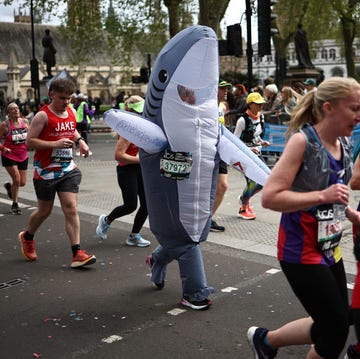We're not keen on the word ‘taper’. The word is synonymous with cutting back or reducing, and often brings anxiety and a feeling of rustiness. The key to getting your marathon taper right is to reframe it and to look at it more holistically, beyond the generic rules.
What is a marathon taper?
Tapering is a process of cutting back training so you can absorb the hard work you’ve done in the peak weeks of training. The goal is to get you to the start line feeling energised and ready to perform, but without losing fitness. Marathon running requires you to get fitter and stronger, but it also demands that you deliver that fitness on one day. So the taper should, in theory, make your race-day performance a little more predictable.
How long should a taper be for a marathon?
The majority of the sports science literature focuses on the physiological aspects of tapering. That is to say, adjusting the frequency, duration, intensity and type of training over a set period of days to reduce load before racing. For the marathon, this has led to the formulation of a broadly standard set of rules:
- Cut back your training volume in the final two or three weeks before race day by reducing the duration of your runs. A common suggestion is to reduce your volumes by roughly 30% two weeks out from the race and by about 50% in race week.
- Three weeks from race day, reduce your long run to around 2:30 hours; two weeks out, 1:45 to 2:00; and a week before the race, 60 to 70 minutes.
- Maintain the frequency of your running, so if you have been running four to five times a week, keep that pattern during your taper.
- Maintain or even slightly increase the intensity of your training.
- Reduce other types of depleting or high injury-risk training, such as heavy strength sessions or team sports.
What else do you need to think about in those last few weeks?
Rather than a separate and distinct block, try to think of your marathon taper as a final period of training – a time to focus on performance readiness and fine-tuning. Is this just semantics? No, it's about a mindset. The dictionary definition of ‘taper’ is to reduce or diminish. But a good period of performance readiness might require scaling down some elements of your training, but increasing some others.
So we'd encourage you to reframe the taper, thinking wider than the purely biophysical rules. Like a sound engineer in a studio, you are subtly adjusting several dials to get your body and mind pitch perfect.
How do some of the best taper?
A 2017 article in the Journal Of Sports Sciences explored the tapering practices of seven Olympic track and field coaches. While the research showed that these coaches did implement many of the conventional rules we have outlined here, they placed a greater emphasis on the psychological aspects of preparation than is normally the case. In addition, they appeared to take a much more adaptive approach in the final two to three weeks – changing training according to how their athletes felt, on a day-to-day basis, if necessary.
Perhaps the best-known example of an unconventional tapering period is that of marathon world record holder Eliud Kipchoge. Kipchoge’s training in the build-up to his victory in the 2017 Berlin Marathon showed his weekly mileage stayed fairly consistent, between 110 and 120 miles a week, right up until race week; only then did he cut back – a little.
British marathon runner Steve Way qualified for the 2014 Commonwealth Games by running 2:16 at the London Marathon. He slept in a camper van the night before he lined up, having only committed to the race a few days before, as part of his training towards a 100km event.
We're not necessarily recommending these approaches to tapering, of course, but we highlight them to illustrate that there is some art and magic involved in getting your best race-day performance.
For example, you might one to look at adapting your training according to whether you are more of a ‘fast runner’ or more of an ‘endurance runner’. If you are the former, you may find you need a slightly longer taper; if you are the latter, you may want to maintain easy and steady mileage closer to race day. Are you a routine-driven person? If so, you may want to keep the frequency of your running the same and not alter your work or nutrition too much.
To sum up, the key to tapering is knowing yourself and having a good understanding of what you are trying to achieve.
How to taper before a marathon – 11 top tips
As mentioned, how you get to a place of performance readiness can be unique to you. This final period of fine-tuning is a process that should be about good decision-making rather than always following convention. Focus on what this period is designed to achieve – a full mental and physical battery on race day – then plan how to get there.
1.Tailor your taper
Just as there’s no one-size-fits-all marathon training plan, there’s no generic taper to fit all runners. The key to tapering is knowing what kind of runner you are, and knowing what you’re trying to achieve. Don’t be confined by 'the rules'; what makes you feel good is important too. Listening your body and being adaptive during this period is a good place to start.
2. Think of it as your final period of training
Instead of thinking of the taper as a distinct block, think of it as your final period of training. Look at the taper as a period to focus on fine tuning and performance readiness. Your training hasn’t just stopped; the taper is the final, crucial part of it.
3. Taper your mental mileage
A lesson from Ethiopian runners, who are, after all, rather good at the marathon. Stop doing 'laps', when you’re not doing 'laps'. Allow us to explain: the Amharric word for laps is zur. While doing zur is a fine thing on the track, one should avoid doing much zur when not training – and particularly when tapering. In this sense, zur means any activity that potentially compromises your ability to rest. A little zur is, of course, unavoidable but think about reducing any stressful tasks, deadlines or other mentally taxing activities before race week. Consider reducing your social media use, too.
4. Lay off the weights
If you’ve been a good, conscientious runner and done your strength and conditioning work (see: the only 7 strength moves you actually need to do), now is the time to step back from the dumbbells. A study found that athletes who strength trained for a number of months and stopped a month before race day, still enjoyed all the benefits to running economy that strength training brings. Lifting heavy weights in the build-up to a race will only leave you with heavy legs on the day.
5. Keep the intensity, drop the volume
Probably the most crucial aspect of a taper is the reduction of mileage, but that doesn’t mean a reduction in the intensity of your runs. A study found that a reduction in volume coupled with high-intensity work a week before race day resulted in the best results. So that means that maintaining a bit of interval work and tempo running in the taper, so long as you scale back the volume of those sessions. Doing so will keep you feeling sharp, but not depleted, on race day.
6. Visualise success
The taper period is a great time to practise mental visualisation. In other words, picturing your desired outcome in your mind. In the weeks leading up to a race, begin to visualise your goal – whether that’s finishing in a particular time, or being able to run the whole distance without stopping. Try to bring it to life: imagine the physical sensations; how you’ll feel upon finishing; the noise of the crowd. Start small, and then add more images each time you do this. You can try to use this to tackle any areas you might be struggling with. For instance, if you’re worried about your running form deteriorating, imagine yourself running strong, with your chest out and arms pumping in the final miles of the marathon.
7. Reduce, maintain, increase
The taper period isn’t just about dialling things down. There are things you should reduce, things you should maintain and things you should increase. On the reduce side of things, you should aim to reduce mileage, mental stress, comparison and risk. Maintain things such as your run frequency, fitness and the intensity (but not duration) of your faster sessions. Aim to increase things such as confidence (do sessions that make you feel good), energy levels (sleep) and responsiveness (listen to your body).
8. Prioritise sleep
Sleep is your best friend during the taper and should be treated with respect. It’s when the muscles recover and the body repairs damaged tissue. The night before the race is bound to be disrupted, so aim to get some quality shuteye in the week beforehand. Nutritionist Kim Pearson recommends as a magnesium supplement one hour before bedtime ‘because magnesium acts as a muscle relaxant and has a calming effect on the brain’. There are other things you can do, too, to encourage better shuteye: no screen time before bed, reduce or cut out alcohol, create a dark and quiet sleep environment.
9. If in doubt, do a bit less
A study from the University of Limburg in the Netherlands confirmed how over-trained endurance runners often are. Researchers tracked changes in the cell of the leg muscles of Dutch runners in the build-up to a marathon. These runners gradually increased their training miles to 48 a week, and then followed a standard taper. Researchers found that 60% of these runners on the start line had muscle damage and depleted glycogen stores. Moral: run a bit less, rest a bit more.
10. No cramming
You will not get fitter during your taper period – and this shouldn’t be the goal, either. So don’t try to cram in long, tough sessions in the hope that you’ll gain some 11th hour fitness; you won’t and will succeed only in knackering or injuring yourself. Trust in the training that you’ve done – even if it’s not as much as you’d hoped. Ninety-five per cent of people on the start line will have had missed training sessions or short lay-offs. You don’t solve this in a taper. Be proud of what you’ve managed to do, hold your nerve and get to the start line ready to do.
11. Eat, drink, be merry
The taper can come with the concern that you’ll put on extra weight due to the fact you’re no longer running the same number of miles. You’ll burn less calories, of course, but let your body tell you how much it needs: don’t put in unnecessary restrictions. Keep yourself topped up with high-quality food, including decent carb-based meals in the week leading up to the race.
Tom Craggs is road running manager for England Athletics











